Devine Escapes, hardscaping contractor, Blakeslee PA
Phone: 610.301.4269 eMail: devin@devineescapes.com
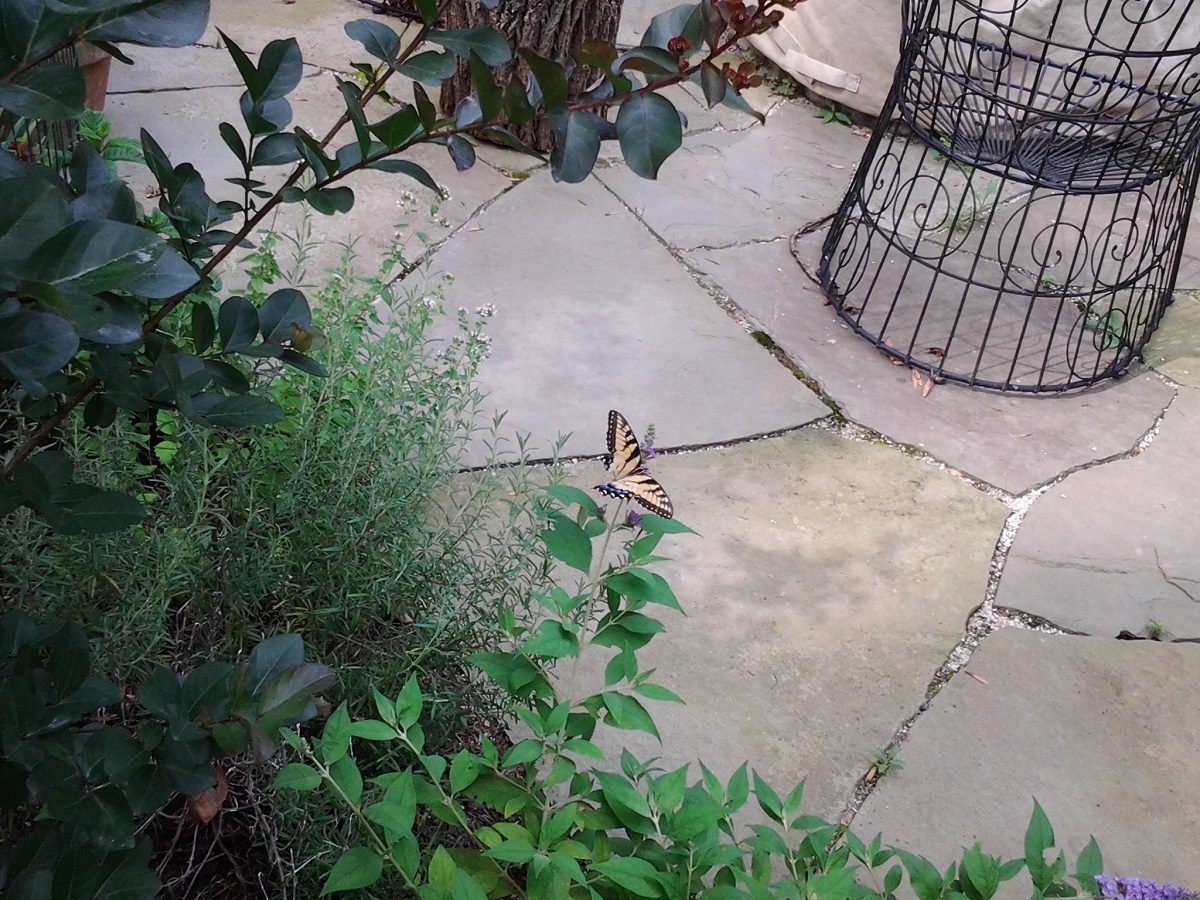
you want to fit them fairly tight….but still have them look natural, not forced.
A gentleman’s wager
So last September I got an email that proposed to point out a mistake on my part:
Hi! I enjoyed your website, learned a lot from it. I want to make sure you are aware that, although you fault Pac Men in irregular flagstone paving, there appears to be a double-mouthed Pac Man in the south by southwest section of Pennsylvania Bluestone Patio photo that tops one of the pages. Just wanted to let you know. Again, great website!
Thanks,
Mike
And I responded:
I’d love to see the link… I’m not really troubled though, I tend to break my own rules/guidelines.
Devin
Well, in truth the pac-man rule is a pretty solid rule, not so much a guideline. It’s unimaginable, that I’d ever let a double pac-man slide. But i didn’t want to come off as arrogant here, so I had to entertain the possibility and even suggest that maybe I do break my own rules. And I do! But a double pac-man is bad taste. Tacky. Never find me guilty of bad taste nor tacky stone work. Not gonna happen.
Related content: DIY flagstone phone consultation service
Wait a minute…there’s “Guidelines for flagstone installation”?
Here I thought you just randomly fit the pieces together, willy-nilly.
The flagstone rules/guidelines that are being referred to here are from one of my flagstone how-to articles, an instruction guide on fitting irregular flagstone pieces in such a way that they look natural, without funny shapes or obvious saw-cuts or the usage of polymeric sand–all common pitfalls for home-owner builders as well as for many contractors who maybe don’t specialize in this particular type of work. And then he came back:
Here’s the link. First photo. Third big stone in from 6 o’clock. https://www.devineescapes.com/flagstone-patios
Mike
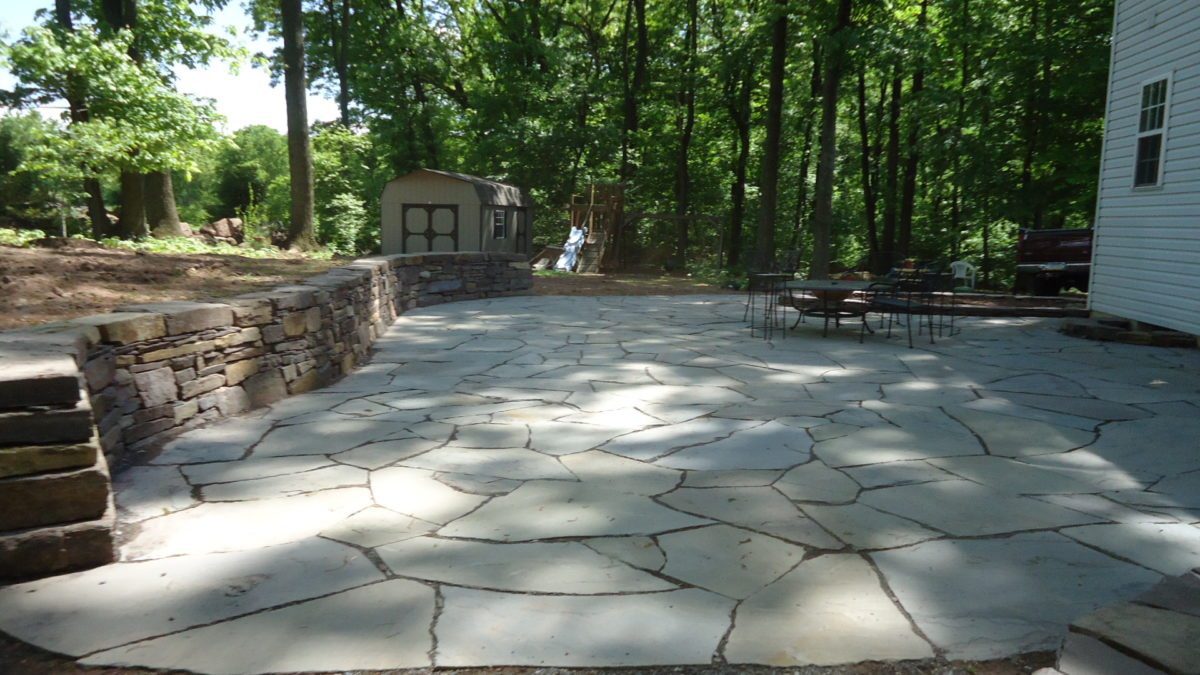
I gotta admit, that sure does look like a really, really bad example of double pac-man. I would never cut a stone in such a way, neither would I pass it, if one of my workers made such a cut. And thinking back to 2010 when this patio was built, I believe I made every single cut myself. Okay, maybe I had others do a lot of the actual cutting, but I still puzzled it all together myself and marked out the cuts for them. There’s just no way…..
I said No Pac-men
The one that shaped like a giant hourglass? No way, that’s two stones, the joint is just obscured. The joint is probably tighter than most and/or the second stone is a little bit lower/ the stone closer to us probably has a bit of a high spot along that edge. When I get home I’ll check the other photos I have on that job. Surely one from another angle will confirm this. I’ll get back to you.
Devin
And later on that day:
The photos are on an old hard drive that I don’t have with me. It will be a week or two until I can access them. In the meantime, care to place a wager? I will wager you one dollar, that I can find an old photo from 7 years ago, proving that the hourglass is two stones.
Devin
These emails were being sent while I was away in Maryland, working on a sculpture. Notice that I did not bet that the stone was not a pac-man–I bet that I could find a vindicating photo on my old hard drive. I knew for a fact that double pac-man was an optical illusion. The only worry–did I have such a photo? 7 years passes by so fast, but it’s a long time. Yes, I could just visit the customers house and get a new photo that proved that I did indeed fit them flagstones together properly–that would suffice to defend my reputation as an awesome flag-stoner, but then I’d still lose the bet.
A month later the project that had me out of town finished, and I had time to look through that hard drive.
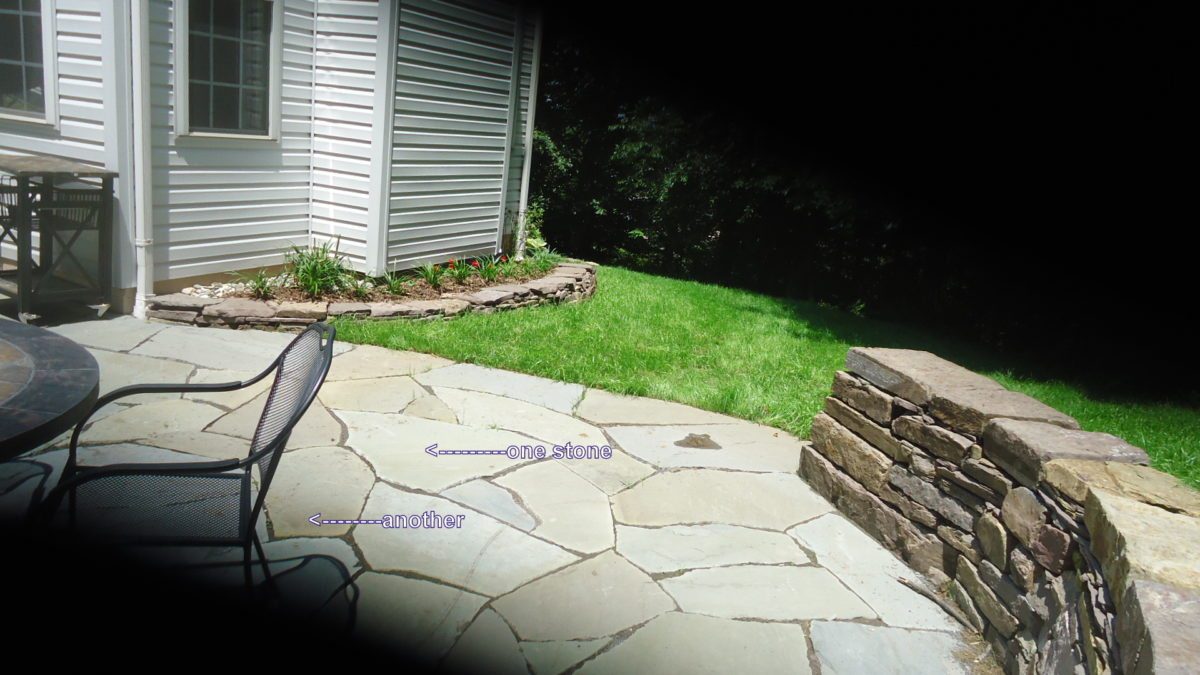
proved it!
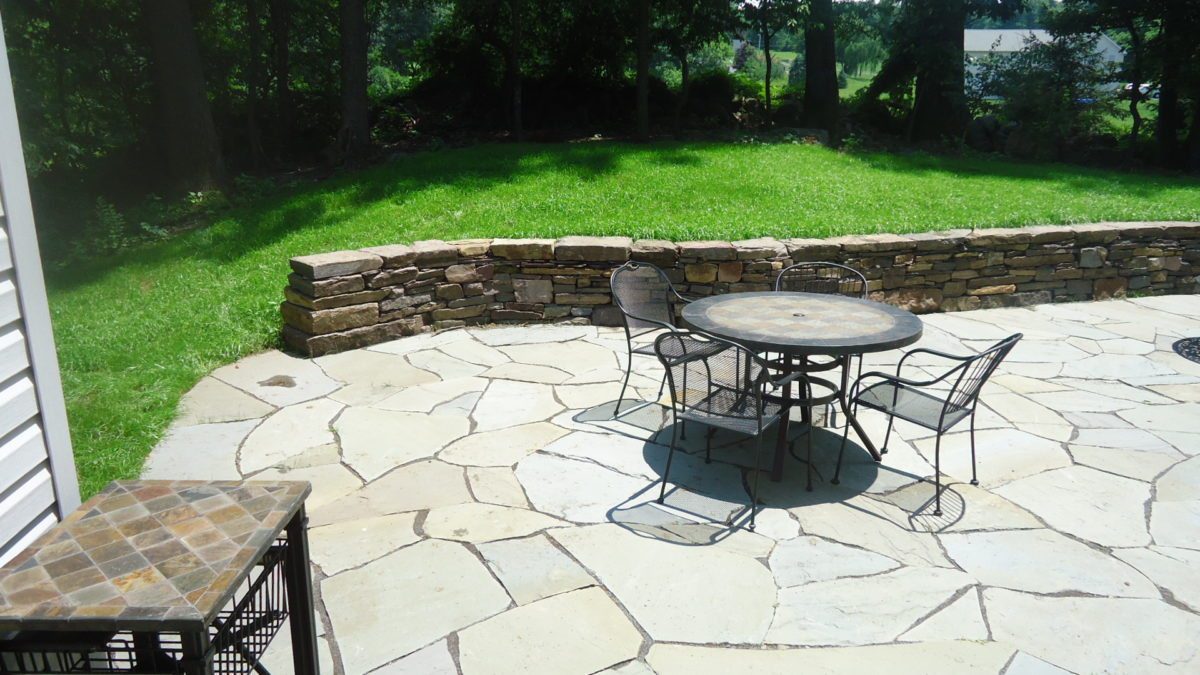
This is an older project–not my very tidiest work perhaps. The joints may seem a bit large compared to my newer works….that’s partly because the joints are probably over-filled in the photo. See the puddle on the stone, upper left? It’s just been topped off with stone dust into the joints and hosed down. I think I’ll call the homeowner and pay them, or this patio anyway, a visit. See how it’s getting along, 9 years later–and get better photos.
Related content: DIY flagstone phone consultation service
DIY Hardscape Help
Phone Call Rates:
$118.00 for an hour long consultation.
$80.00 for a half-hour consultation.
These consultations can also be conducted via email.
Monies are payable via Venmo Zelle, PayPal, or check.
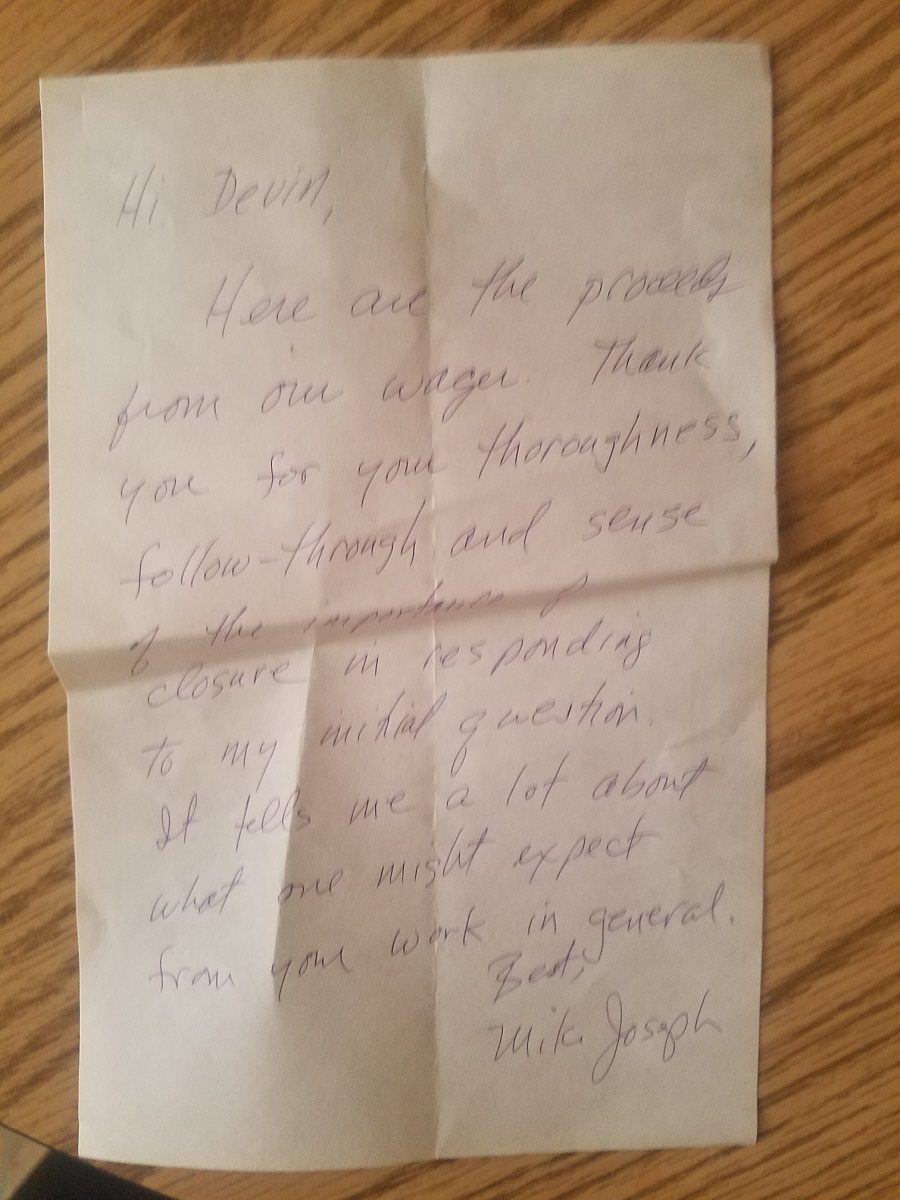
related content. How-to cut flagstone video:
Included in the hand written mail was of course a dollar bill. I have a photo of it somewhere…
Thanks, Mike. It was good talking with you–and a pleasure taking your money.
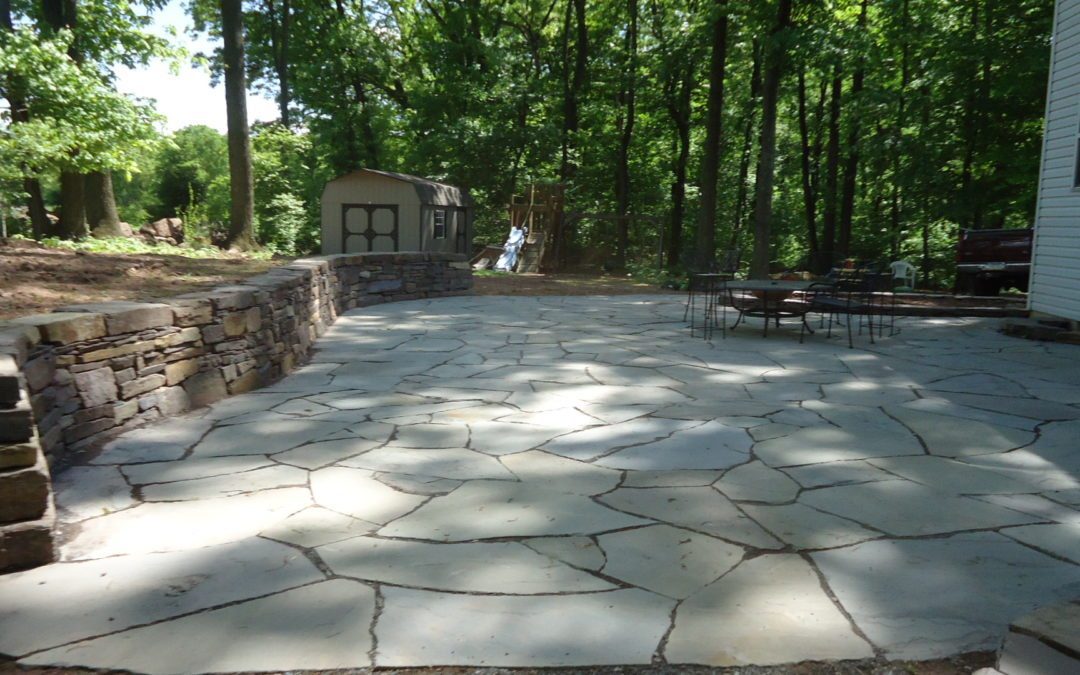
Devin:
I read your blog and have this existing cement patio that has been in my backyard for years. We painted it to make it look better but now want to resurface it with flagstone! We live in New Hampshire where the weather has freeze and thaw issues. The cement patio is in great shape and tying to figure out the best course of action. We love flagstone and I saw Idaho Quartzite flagstone is durable and comes in 3/4-1” thickness. Would this work for our purposes and mortar bed with polymetric sand for joints? What would be your recommendation? I have attached a picture of our existing patio.
Thanks so much!
Lisa
You could go either way–either dry lay a patio right on top of the existing concrete pad, using stone dust as your leveling agent and joint filler, OR you could use a mortar bed and a mortar joint.
In no way should you use polymeric sand. If you set the flagstones down on mortar, joint them with mortar too. If you dry lay them on stone dust, then use stone dust as you joint filler…..yes, you could use polymeric sand if you were dry laying but I would not recommend it.
Personally, just about the only time I ever lay flagstone in mortar is if there happens to be a pre-existing concrete pad in good shape. New Hampshire winters are hard on any grade level mortar or concrete. Yes, your concrete pad has had luck–that does not mean your mortar joints will.
Dry laying on top of a concrete pad may seems sort of funny(and yes, I would generally wet lay, in a situation like yours), but:
-if the concrete pad already has a decent pitch, say one inch of fall for every 4 feet of span, or somewhere around there
-and if you use flagstones that are 1.5 inch or thicker
-have a varying stone dust bed of half an inch or more, so there’s some cushion between the flagstone and the concrete
-keep your joints reasonably tight, like less than 3 inches, more like 1 inch, if you can.
Follow those guidelines and you certainly can successfully dry lay on an existing concrete base. the stone dust beneath the flagstones might hold some moisture, but in my experience, the stone dust won’t get saturated, shouldn’t cause a problem BUT I’d avoid using limestone dust in this case as it is know for holding on to moisture.
If you need further individual help, say if you plan to DIY or whatever, I do offer 1 on 1 help.
Good luck with your patio and I hope this helps!
Devin, Great website; most valuable info is posted there. I live in
Mississippi. We don’t have much freezing weather and not for more than a few days at a time. Am redoing joints in irregular blue stone walkway. Remnants in joints appear to be very coarse slag (3/4″ and finer maybe). Stones are 1 to 2″ thick and laid on mix of soil (high clay content here) and sand, mixed with some slag in places. Stones are quite stable and even. No signs of significant shifting except for a few stones. Joints are mostly 1 to 2″ wide with a few 3 to 4″. After a search, only choices for gray joint material in this region seem to be Polysweep, Gator Dust or crushed limestone that landscape suppliers refer to as 1/4 minus but it has some larger chips in it, maybe 3/8 and finer. I know your feelings on the first two options. Any downside to using the crushed limestone product? It is our preferred look (natural rough surface, not smooth concrete look and feel) and color looks great. I found a place that has gray decomposed granite about 6 hours away in Texas, but prefer a local source.
I’d go with the crushed limestone.
Crushed limestone sometimes gets a bad rap in hardscape how-to articles and in industry certification courses. Crushed limestone fines hold on to water longer than other types of stone dust. So if you build a patio on 6 inches of 3/4″ minus, than use 1/4″ minus as your leveling agent and joint filler–then you might (or might not) have a situation where your hardscapes foundation is staying damp for too long, potentially leading to various problems.
In practice however, I see crushed limestone being sold by many suppliers and used by many hardscape contractors–and those jobs do not end up needing repair more often than jobs built with other types of crushed stone.
Personally, I prefer not to use crushed limestone for foundations, but have zero concern when considering it for a flagstone joint material. I even have one job where I used crushed limestone as the joint material for the walkway, and crushed bluestone for the patio. The customer is a repeat customer and I visit the property every every couple years–both types of stone dust have performed equally as a flagstone joint material, over the years.
Hi Devin, thank you for your help thus far! Our phone consultation was very useful and your website has so much information.
One final question — I have demo’ed the old patio down to a concrete pad in decent condition which I want to dry lay on top of. I have about 5” to fill before the bluestones go down, so would it work if I lay some gravel (size?) for the bottom 3” (compacted) followed by 2” of QP and then fill the joints with stone dust?
Brooke,
I’m happy to help. What’s “QP?”
In your situation, I would:
1. Lay about 4.5″ of gravel, sized 3/4″ minus (or 1″ minus).
2. Compact that.
3. Set out all of the flagstones, trimming with hammer and/or grinder, as needed.
4. Use stone dust as a leveling agent, lifting stones 2 at a time and adding half an inch, or an inch, of stone dust as needed.
5. Use the same stone dust as joint material.
Thank you, Devin! QP is “quarry process” at my local stone yard — I think it’s a mix of 3/4 minus and stone dust.
For the 3/4” gravel base, should that be “clean”?
“Clean” means no fines = not compactable.
You want 3/4″ minus road base type gravel for the foundation, 1/4″ minus (stone dust, DG) for the leveling agent and joint material.
Thank you!!